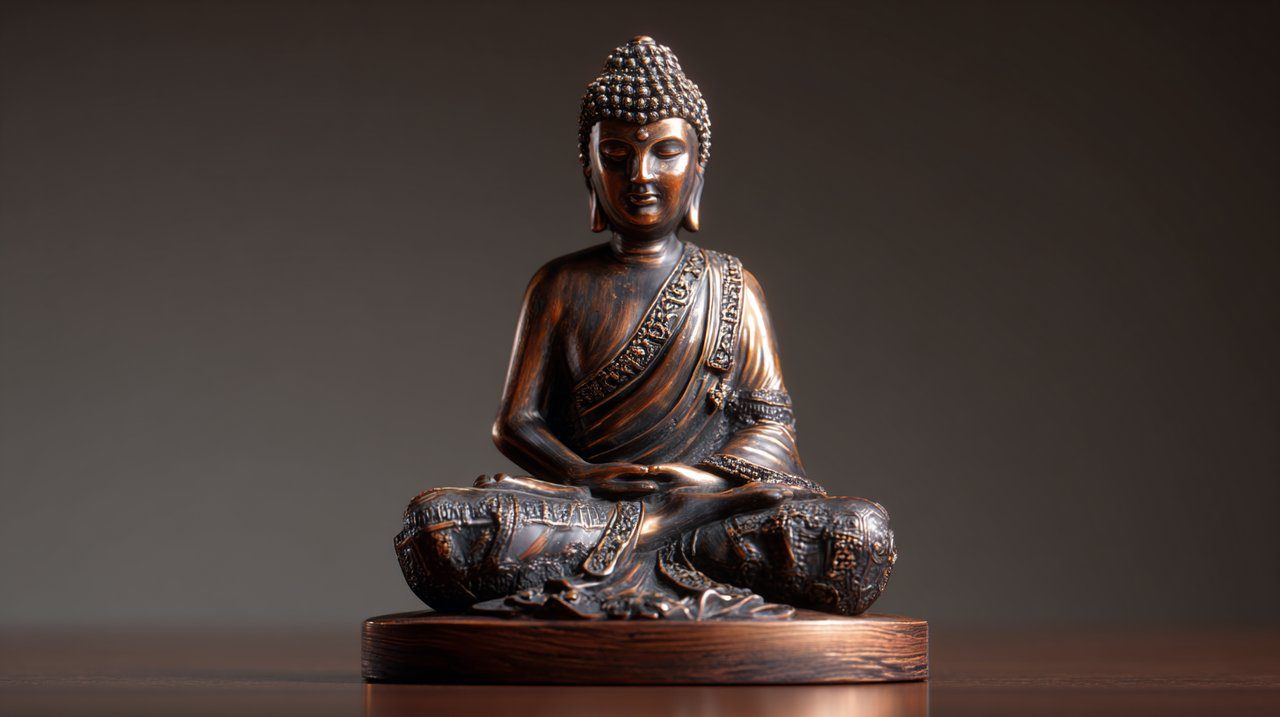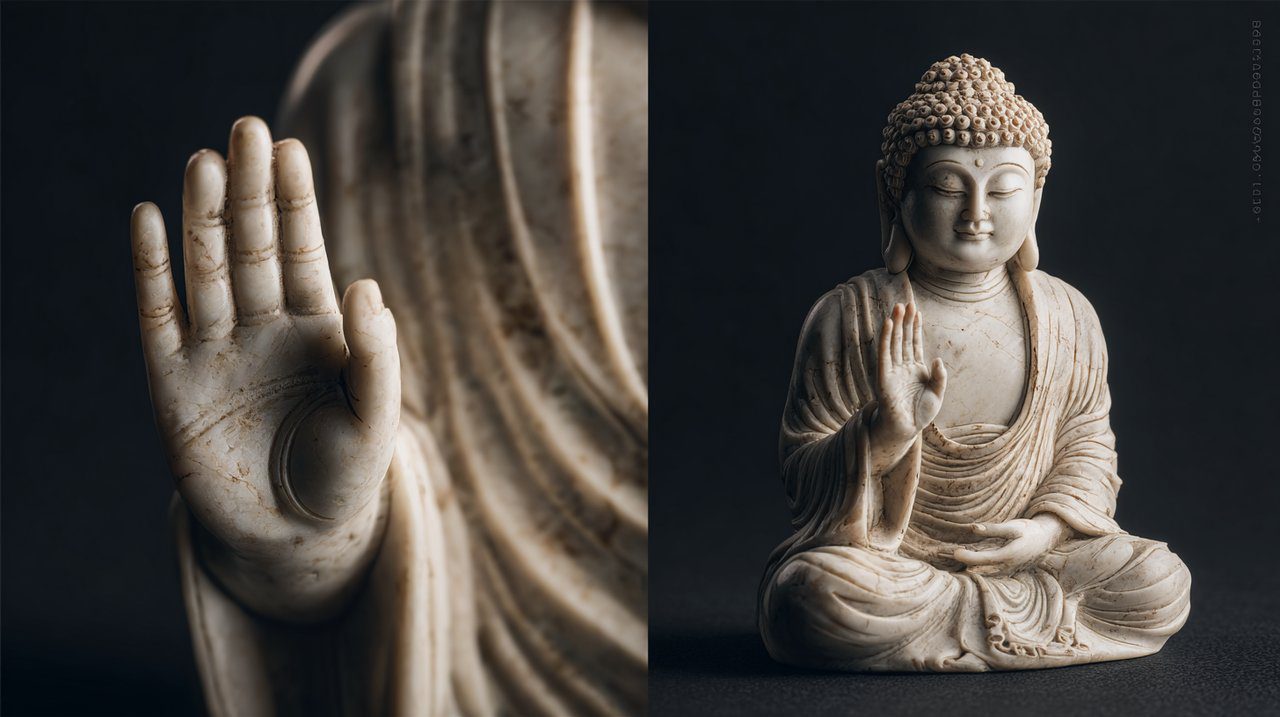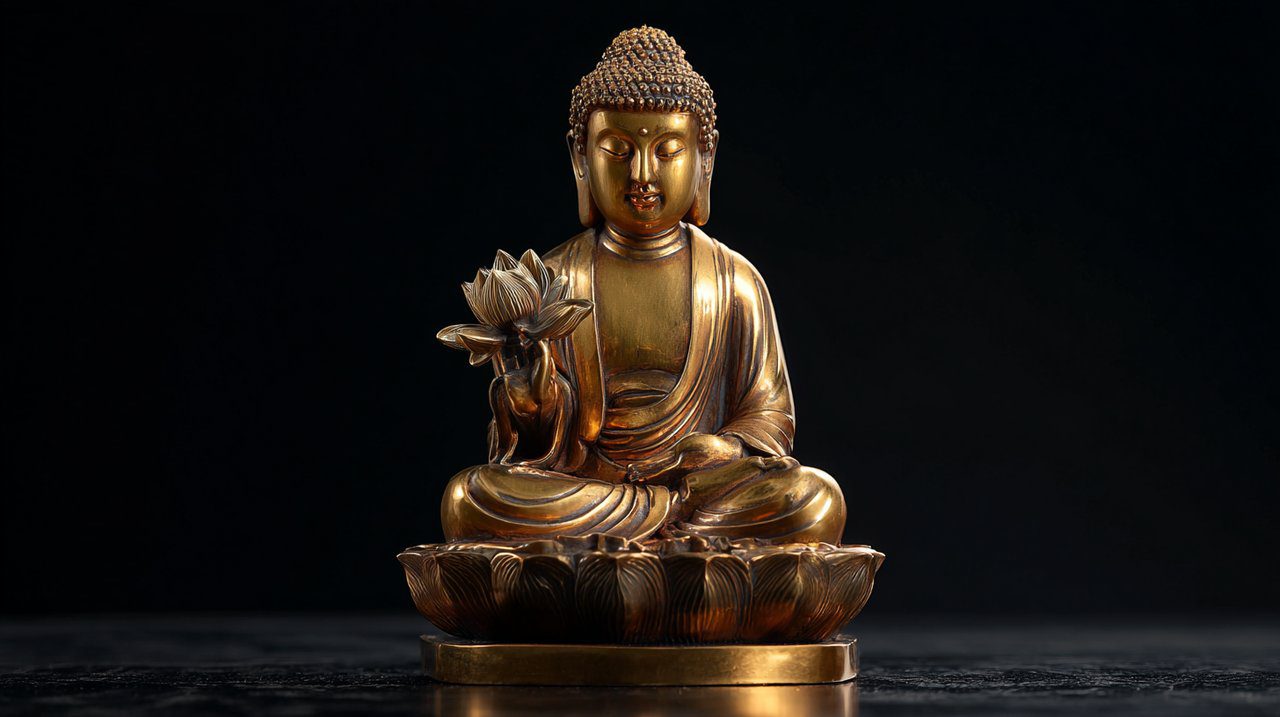The Silent Language of Enlightenment: Decoding Buddhist Statues
Beyond their undeniable artistic beauty, Buddhist statues are much more than mere decorative objects. They are profoundly intricate visual texts, each element meticulously crafted to convey deep spiritual teachings and pathways to awakening. Every curve, every gesture, and every subtle detail serves as a deliberate symbol, offering a direct, non-verbal connection to the very essence of Buddhist philosophy.
These sacred forms beckon us to move beyond simple observation, inviting us to decipher and internalize a timeless wisdom that speaks directly to our contemporary search for meaning, compassion, and inner stillness.
Decoding this ancient visual language is not merely an academic pursuit; it is an invitation to a transformative inner journey. It reveals profound insights into the nature of existence and offers tangible guidance for navigating the complexities of modern life.
Decoding Buddhist Iconography: A Visual Journey
Buddhist statues are far more than ancient relics; they are enduring testaments to a spiritual tradition spanning millennia. Consider them not merely decorative items, but rather as dynamic sacred maps for the soul’s awakening.
The iconography of these figures, developed and refined over centuries across diverse cultures, is meticulously crafted. Every detail conveys specific teachings, profound states of being, and tangible pathways to liberation. By truly understanding these visual metaphors, we transition from simply admiring their aesthetic appeal to engaging in a deeper dialogue with the profound spiritual truths they embody.
To embark on this journey, we will explore the foundational elements that define Buddhist iconography: the body’s sacred stances, the eloquent language of hand gestures (mudras), and the rich array of symbolic attributes.

Postures of Presence: Decoding Sacred Stances
The distinct ways a Buddha or Bodhisattva is positioned are not merely aesthetic choices; they are profound deliberate spiritual statements. Each physical stance conveys specific teachings, commemorates pivotal moments, or illustrates states of ultimate realization.
Every posture serves as an invitation to pause, contemplate, and reflect deeply on the intrinsic qualities it embodies. By understanding these forms, we gain insight into the journey toward awakening.
The Lotus Position (Dhyanasana): Meditation and Serenity
The lotus position, or Dhyanasana, is arguably the most recognizable posture. The figure is seated with legs crossed, feet resting on opposite thighs, and soles facing upwards. This pose powerfully symbolizes unwavering stability, profound meditative absorption, and dedicated commitment to the path of enlightenment.
It beautifully encapsulates the perfect equilibrium required for deep spiritual concentration—a state of tranquil absorption where external distractions naturally dissolve. Consider it akin to discovering your unshakeable inner core, even amidst life’s relentless currents.
Standing and Walking: Active Engagement and Compassion
While seated meditation is foundational, the dynamic poses of standing or walking carry equally significant meaning. A standing Buddha, for instance, powerfully embodies active compassion and the diligent act of teaching, illustrating the Buddha’s direct engagement with the world to disseminate the Dharma.
A walking Buddha, particularly prevalent in Thai artistry, gracefully conveys fluid movement, deep inner peace, and the continuous journey of spiritual awakening. It symbolizes the Buddha’s emergence from rigorous asceticism, poised to teach and guide all beings.
Reclining Buddha: Parinirvana and Ultimate Liberation
The reclining Buddha, typically depicted lying on its right side with the head gently supported, illustrates the Buddha’s Parinirvana. This portrayal is not a symbol of ordinary death, but rather his ultimate passing into complete liberation and absolute freedom from the cycle of rebirth (samsara).
This pose profoundly embodies serene transcendence and the attainment of ultimate nirvana. It signifies the peaceful completion of his earthly journey and the final release from all forms of suffering, representing an unparalleled state of ultimate peace and spiritual fulfillment.
Mudras: Hand Gestures of Divine Communication
Mudras, these symbolic hand gestures, are profoundly powerful. They precisely communicate specific meanings and evoke distinct states of mind within Buddhist iconography. Each mudra can be understood as a condensed spiritual teaching, a visual mantra, or a non-verbal affirmation.
They serve as direct conduits, guiding us towards understanding complex spiritual concepts and cultivating specific emotional qualities. These gestures offer a silent, eloquent language that speaks directly to our inner landscape.
Bhumisparsha Mudra: Earth-Touching Witness
The Bhumisparsha Mudra, frequently depicted with the right hand touching the earth, marks the pivotal moment of Siddhartha Gautama’s enlightenment beneath the Bodhi tree. It symbolizes his profound act of calling the Earth to witness his awakening and his ultimate triumph over all Mara’s temptations.
This potent gesture embodies unshakeable resolve and the realization of ultimate truth—a definitive declaration that his spiritual quest was complete and irrefutable.

Dhyana Mudra: Gesture of Meditative Absorption
For the Dhyana Mudra, both hands rest peacefully in the lap, palms facing upwards, often with the right hand gently placed over the left. This gesture exquisitely symbolizes profound concentration, spiritual unity, and the culmination of wisdom.
It is universally seen in meditating figures, perfectly embodying the continuous cycle of introspective spiritual practice and unwavering mindfulness.
Abhaya Mudra: Fearlessness and Protection
The Abhaya Mudra is readily identifiable: the right hand is raised to shoulder height, palm facing outwards, with fingers extended upwards. This gesture powerfully communicates reassurance, divine protection, and the profound dispelling of fear.
It stands as a deeply comforting symbol, offering solace and reminding us of the Buddha’s boundless compassion and his inherent capacity to guide us through life’s challenges.
Varada Mudra: Bestowal and Compassion
With the right hand extended downwards and the palm facing outwards, the Varada Mudra symbolizes offering, boundless compassion, and the granting of spiritual blessings. It is a potent representation of generosity and benevolent charity.
This mudra profoundly reflects the Bodhisattva’s unwavering commitment to alleviating suffering and bestowing blessings upon all sentient beings, embodying a spirit of selfless giving and the realization of noble aspirations.
Exploring Iconography: Sacred Attributes and Objects
Beyond the fundamental postures and mudras, Buddhist statues are further enriched by a diverse array of symbolic attributes and sacred objects. Each of these elements adds intricate layers of meaning to the figure’s profound spiritual narrative.
These meticulously crafted details offer deeper insights into the enlightened state and the transformative path to achieving it, unveiling stories far more profound than initially meet the eye.
The Urna and Usnisha: Marks of Supreme Wisdom
Let us delve into two distinct marks of profound wisdom. The Urna is the small, round dot frequently observed between the eyebrows, symbolizing the third eye of spiritual insight and supreme wisdom—a clear emblem of deep inner vision and intuitive understanding.
The Usnisha, a cranial protuberance on the crown of the head, represents the Buddha’s expanded consciousness and ultimate enlightenment. It signifies that his mind has fully blossomed to its utmost potential, reaching a state of perfect realization.
Haloes and Mandorlas: Emblems of Divine Radiance
You will also notice haloes, which encircle the head, and mandorlas, which encompass the entire body. These luminous auras are compelling visual indicators.
They symbolize divine radiance, spiritual luminescence, and the sacred sanctity of the enlightened being, unequivocally signifying their transcendent nature and immense spiritual energy.
Sacred Objects: Bowls, Lotus, Dharma Wheel
Many figures also hold or are depicted alongside various objects, each imbued with its own specific meaning:
- Alms Bowl: This simple bowl profoundly represents humility, renunciation, and the monastic life of seeking sustenance. It signifies a deep acceptance of life’s provisions, free from attachment.
- Lotus Flower: A universally potent symbol of purity, spiritual awakening, and enlightenment. It beautifully illustrates how one can emerge unsullied from muddy waters, signifying growth amidst adversity. Different colors (white, pink, blue) convey additional nuances of spiritual development.
- Dharma Wheel (Dharmachakra): This iconic wheel symbolizes the Buddha’s teachings and the entire path to liberation. Its eight spokes represent the Noble Eightfold Path, guiding practitioners toward profound enlightenment.
Other revered items, such as dzi beads, are also frequently seen as protective and spiritually potent talismans, highly valued for their perceived ancient wisdom and karmic benefits.
Colors and Materials: Reflecting Spiritual Qualities
Even the chosen materials and colors for these statues are far from arbitrary; they consistently amplify the symbolic meaning. Gold, for instance, represents purity, inherent preciousness, and the incorruptible, enduring nature of the Dharma.
Distinct colors of Buddhas—such as blue for Akshobhya or white for Vairocana—correspond to specific Dhyani Buddhas and their associated wisdoms or spiritual attributes. This introduces yet another intricate layer, profoundly enriching the iconic narrative and its interpretive possibilities.

Beyond Form: Integrating Ancient Wisdom for Modern Life
The profound wisdom encapsulated within Buddhist statues transcends their ancient origins, offering far more than historical insight. These forms provide potent, universal principles directly applicable to our modern quests for inner peace, mindfulness, and authentic self-discovery.
Far from being mere relics of the past, these symbols serve as dynamic, living guides, perpetually ready to inform and enrich our contemporary spiritual and daily practices. They bridge the ancient and the present, offering a timeless framework for personal growth.
Statues as Meditative Anchors
Understanding the intricate symbolism of postures, mudras, and attributes can profoundly transform a statue from a mere object of art into a powerful meditative anchor. These visual guides become catalysts for internal reflection and practice.
For example, when you gaze upon a Dhyana Mudra, let it inspire a deeper sense of focus in your own meditation, guiding you towards sustained concentration amidst daily distractions. Similarly, witnessing the Bhumisparsha Mudra can serve as a potent reminder of your inherent inner strength, empowering you to stand firm and overcome life’s significant challenges, much like the Buddha’s unwavering resolve.
These visual cues function as dynamic focal points, drawing us deeper into our personal practices and fostering a more profound, embodied sense of presence in our lives.
Finding Personal Meaning in Universal Symbols
These ancient symbols articulate universal truths that resonate profoundly with the human condition, transcending cultural and temporal boundaries. Consider how their essence can be integrated into your daily experience:
- Abhaya Mudra (Fearlessness): When facing anxiety or a daunting task, visualize this gesture. How might embodying its spirit allow you to approach challenges with greater courage and clarity, dispelling apprehension?
- Varada Mudra (Compassion & Giving): Reflect on this gesture when considering acts of generosity. How can you extend kindness, support, or understanding to others in a way that truly alleviates their suffering, mirroring the Bodhisattva’s selfless giving?
- Usnisha (Profound Wisdom): In moments of decision or confusion, recall this mark of expanded consciousness. How might cultivating a broader perspective lead to clearer insights and more enlightened choices in your own life?
These are not merely abstract concepts; they are potent aspirations for our own personal evolution. They serve as a constant reminder that the path to inner peace, self-awareness, and compassionate action is universally accessible. By actively engaging with their meaning, we gain a powerful framework for cultivating virtues and navigating life’s complexities with greater wisdom.
By learning to decipher the silent, profound language encoded within Buddhist statues, we unlock an unparalleled treasury of wisdom. Each posture, gesture, and attribute transforms into a personal guide, gently yet powerfully inviting us to look inward and uncover the enduring truths residing within ourselves.
This journey of understanding elevates mere observation into a deeply personal and transformative spiritual encounter. It seamlessly bridges the ancient world with our contemporary quest for meaning, offering a tangible connection to universal principles.
As these magnificent statues maintain their silent vigil across time, they offer more than just historical narratives; they extend a living, timeless invitation to cultivate profound peace, unwavering wisdom, and boundless compassion in our own lives, shaping our reality, moment by moment.
💡 Frequently Asked Questions
Buddhist statues serve as visual scriptures and sacred maps for the soul, offering a direct, non-verbal connection to Buddhist philosophy. They convey specific teachings, states of being, and pathways to awakening, inviting understanding and internalization of ancient wisdom.
The three foundational elements for decoding Buddhist iconography are the body's sacred stances (postures), the eloquent language of hand gestures (mudras), and the rich array of symbolic attributes like sacred objects, marks, colors, and materials.
The Lotus Position, or Dhyanasana, symbolizes stability, deep meditation, and an unwavering commitment to the path of enlightenment. It embodies the balance needed for profound spiritual concentration and a state of serene absorption.
Mudras are symbolic hand gestures within Buddhist iconography that communicate specific meanings and evoke particular states of mind. Each mudra is a condensed teaching, guiding understanding of profound spiritual concepts and emotional qualities.
Understanding the symbolism in Buddhist statues can transform them into powerful meditative anchors, inspiring deeper concentration and inner strength. These universal symbols offer a framework for personal growth, helping individuals cultivate peace, wisdom, and compassion in their daily lives.








